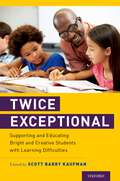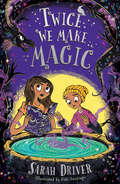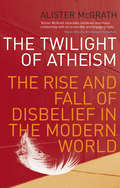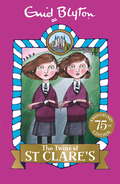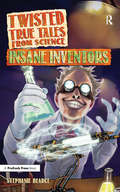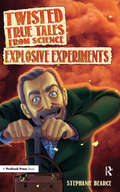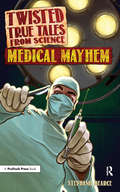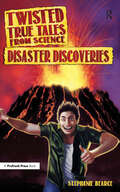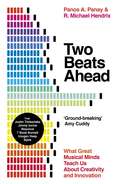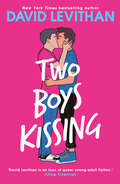- Table View
- List View
Twenty Teachers
by Ken MacrorieThe rare and exceptional teacher--one who could teach absolutely anything to anybody--is what Ken Macrorie set out to find among teachers of many different subjects at many different levels. The result of his search is 20 Teachers, a collection of revealing profiles in which outstanding educators explain what works for them in the classroom and why. Macrorie's interviews with these professionals show an astonishing similarity in their beliefs, methods, and attitudes and the keys to their success with students from first grade to the graduate level. Ranging from a woodworking instructor in a wealthy suburban school to an inner-city history teacher to a professor of space engineering, the teachers profiled here share a fundamental belief in putting choice and responsibility in the hands of their students, no matter what their age. Macrorie includes, in addition to the interviews, a summary chapter listing 43 items these teachers claim help learners to do "good works." Finally, in an "Open Letter About Schools," he explores the notion that schools have developed, often unwittingly, traditions that run counter to the way these educators work; he discusses the obstacles they face, from both within the system and without. Twenty Teachers offers insights that will enable others to inspire learning in their students and voices a new and challenging view of today's educational system.
Twice Exceptional: Supporting and Educating Bright and Creative Students with Learning Difficulties
by Scott Barry KaufmanIn an educational system founded on rigid standards and categories, students who demonstrate a very specific manifestation of intelligence flourish, while those who deviate tend to fall between the cracks. Too often, talents and interests that do not align with classroom conventions are left unrecognized and unexplored in children with extraordinary potential but little opportunity. For twice-exceptional (2e) children, who have extraordinary strengths coupled with learning difficulties, the problem is compounded by the paradoxical nature of their intellect and an unbending system, ill-equipped to cater to their unique learning needs. Twice Exceptional: Supporting and Educating Bright and Creative Students with Learning Difficulties provides cutting-edge, evidence-based approaches to creating an environment where twice-exceptional students can thrive. Viewing the 2e student as neither exclusively disabled nor exclusively gifted, but, rather, as a dynamic interaction of both, leading experts offer holistic insight into identification, social-emotional development, advocacy, and support for 2e students. With chapters focusing on special populations (including autism, dyslexia, and ADHD) as well as the intersection of race and 2e, this book highlights practical recommendations for school and social contexts. In expounding the unique challenges faced by the 2e population, Twice Exceptional makes a case for greater flexibility in our approach to education and a wider notion of what it means to be academically successful.
Twice Exceptional: Supporting and Educating Bright and Creative Students with Learning Difficulties
In an educational system founded on rigid standards and categories, students who demonstrate a very specific manifestation of intelligence flourish, while those who deviate tend to fall between the cracks. Too often, talents and interests that do not align with classroom conventions are left unrecognized and unexplored in children with extraordinary potential but little opportunity. For twice-exceptional (2e) children, who have extraordinary strengths coupled with learning difficulties, the problem is compounded by the paradoxical nature of their intellect and an unbending system, ill-equipped to cater to their unique learning needs. Twice Exceptional: Supporting and Educating Bright and Creative Students with Learning Difficulties provides cutting-edge, evidence-based approaches to creating an environment where twice-exceptional students can thrive. Viewing the 2e student as neither exclusively disabled nor exclusively gifted, but, rather, as a dynamic interaction of both, leading experts offer holistic insight into identification, social-emotional development, advocacy, and support for 2e students. With chapters focusing on special populations (including autism, dyslexia, and ADHD) as well as the intersection of race and 2e, this book highlights practical recommendations for school and social contexts. In expounding the unique challenges faced by the 2e population, Twice Exceptional makes a case for greater flexibility in our approach to education and a wider notion of what it means to be academically successful.
Twice-Exceptional Gifted Children: Understanding, Teaching, and Counseling Gifted Students
by Beverly A. TrailGifted students with disabilities, also referred to as twice-exceptional children, need the strategies in Twice-Exceptional Gifted Children: Understanding, Teaching, and Counseling Gifted Students in order to find success in the regular classroom. By offering a thorough discussion of twice-exceptional students based on research into how gifted students with disabilities learn, the author helps teachers and education professionals develop a broad understanding of the complex issues associated with gifted students who have disabilities.This comprehensive text provides an overview of who these students are, how teachers can tap into their strengths and weaknesses, and what educational strategies should be implemented to help these students succeed in school and beyond. The book will guide a collaborative team step-by-step through the process of identifying students' needs, selecting modifications and accommodations, and developing a comprehensive plan to meet the diverse needs of twice-exceptional children. By implementing the strategies suggested in this book, teachers of twice-exceptional gifted students can ensure these students do not just survive in the classroom, but thrive.
Twice-Exceptional Gifted Children: Understanding, Teaching, and Counseling Gifted Students
by Beverly A. TrailGifted students with disabilities, also referred to as twice-exceptional children, need the strategies in Twice-Exceptional Gifted Children: Understanding, Teaching, and Counseling Gifted Students in order to find success in the regular classroom. By offering a thorough discussion of twice-exceptional students based on research into how gifted students with disabilities learn, the author helps teachers and education professionals develop a broad understanding of the complex issues associated with gifted students who have disabilities.This comprehensive text provides an overview of who these students are, how teachers can tap into their strengths and weaknesses, and what educational strategies should be implemented to help these students succeed in school and beyond. The book will guide a collaborative team step-by-step through the process of identifying students' needs, selecting modifications and accommodations, and developing a comprehensive plan to meet the diverse needs of twice-exceptional children. By implementing the strategies suggested in this book, teachers of twice-exceptional gifted students can ensure these students do not just survive in the classroom, but thrive.
Twice-Exceptional Gifted Children: Understanding, Teaching, and Counseling Gifted Students
by Beverly A. TrailTwice-Exceptional Gifted Children, Second Edition provides informed recommendations for improving screening, identification, and services for gifted students with disabilities. This essential resource equips educators with an overview of who these students are, how teachers can tap into their strengths and support their weaknesses, and educational strategies to help them succeed in school and beyond. Thoroughly revised and updated to reflect the latest research and advances in the field, the Second Edition includes new content outlining the positive and negative impacts of Response to Intervention (RtI) on twice-exceptional learners and recommends comprehensive assessments to identify their strengths and challenges, determine significant discrepancies in abilities, and evaluate any impacts on their learning and academic performance. This new edition also includes revised recommendations for screening and identifying twice-exceptional students, critical insights for understanding and supporting mental health issues, and updated analysis from the DSM-5 for Autism Spectrum Disorder, Specific Learning Disorder, and ADHD. Ideal for teachers, coaches, and administrators looking to better understand their most talented learners, the fresh strategies, updated definitions, and comprehensive assessments included in this book will ensure that twice-exceptional gifted students don’t just survive in the classroom, but thrive.
Twice-Exceptional Gifted Children: Understanding, Teaching, and Counseling Gifted Students
by Beverly A. TrailTwice-Exceptional Gifted Children, Second Edition provides informed recommendations for improving screening, identification, and services for gifted students with disabilities. This essential resource equips educators with an overview of who these students are, how teachers can tap into their strengths and support their weaknesses, and educational strategies to help them succeed in school and beyond. Thoroughly revised and updated to reflect the latest research and advances in the field, the Second Edition includes new content outlining the positive and negative impacts of Response to Intervention (RtI) on twice-exceptional learners and recommends comprehensive assessments to identify their strengths and challenges, determine significant discrepancies in abilities, and evaluate any impacts on their learning and academic performance. This new edition also includes revised recommendations for screening and identifying twice-exceptional students, critical insights for understanding and supporting mental health issues, and updated analysis from the DSM-5 for Autism Spectrum Disorder, Specific Learning Disorder, and ADHD. Ideal for teachers, coaches, and administrators looking to better understand their most talented learners, the fresh strategies, updated definitions, and comprehensive assessments included in this book will ensure that twice-exceptional gifted students don’t just survive in the classroom, but thrive.
Twice We Make Magic
by Sarah DriverThe second spellbinding adventure in the magical middle grade series by the author of The Huntress, perfect for fans of Starfell, Nevermoor and A Pinch of Magic.
The Twilight Of Atheism: The Rise and Fall of Disbelief in the Modern World
by Alister McGrathAtheism is one of the most important movements in modern Western culture. For the last two hundred years, it seemed to be on the verge of eliminating religion as an outmoded and dangerous superstition. Recent years, however, have witnessed the decline of disbelief and a rise in religious/spiritual devotion throughout the world. In this highly readable book, the distinguished historian and theologian, Alister McGrath examines what went wrong with the atheist dream and explains why religion and faith are destined to play a central role in the twenty-first century. A former atheist who is now one of Christianity's foremost scholars, McGrath traces the history of atheism from its emergence in eighteenth-century Europe as a revolutionary worldview that offered liberation from the rigidity of traditional Christianity and the oppression of tyrannical monarchs, to its golden age in the first half of the twentieth century. Blending thoughtful, authoritative historical analysis with incisive portraits of such leading and influential atheists as Sigmund Freud, Marx and Richard Dawkins, McGrath exposes the flaws at the heart of atheism and argues that the renewal of faith is a natural, inevitable and necessary response to its failures.
Twin Mythconceptions: False Beliefs, Fables, and Facts about Twins
by Nancy L. SegalTwin Mythconceptions: False Beliefs, Fables, and Facts about Twins sheds new light on over 70 commonly held ideas and beliefs about the origins and development of identical and fraternal twins. Using the latest scientific findings from psychology, psychiatry, biology, and education, the book separates fact from fiction. Each idea about twins is described, followed by both a short answer about the truth, and then a longer, more detailed explanation. Coverage includes embryology of twins, twin types, intellectual growth, personality traits, sexual orientation of twins, marital relationships, epigenetic analyses, and more. Five appendices cover selected topics in greater depth, such as the frequency of different twin types and the varieties of polar body twin pairs. This book will inform and entertain behavioral and life science researchers, health professionals, twins, parents of twins, and anyone interested in the fascinating topic of twins.Identifies common misunderstandings about twinsProvides scientific answers to questions about twinsEncompasses the biology, psychology, genetics, and personality of twinsIncludes discussion of identical, fraternal same-sex, and fraternal opposite-sex twinsAllows for quick answers to common questions and more detailed explanations
Twin-Win Research: Breakthrough Theories and Validated Solutions for Societal Benefit, Second Edition (Synthesis Lectures on Professionalism and Career Advancement for Scientists and Engineers)
by Ben ShneidermanThe thrill of discovery and the excitement of innovation mean that research is often immensely satisfying. But beyond the personal satisfaction, the goal of research is to improve the lives of people everywhere by driving revolutionary advances in healthcare, education, business, and government. This guidebook's strategies will help you shape your research and energize your campus so as to achieve the Twin Win: a breakthrough theory that's published and a validated solution that's ready for dissemination. The action-oriented paths in this guidebook resemble a backpacker's guide to hiking. It suggests paths and gives you enough information to get started, while providing enough flexibility to take side treks and enough confidence to find your own way. Short-term projects include inviting speakers to campus, choosing appropriate research projects, and developing networking skills. Middle-term include seeking funding from government agencies and philanthropic foundations, sharpening your writing and speaking skills, and promoting teamwork in research groups. Long-term missions include changing tenure policies, expanding collaboration with business and civic partners, and encouraging programs that combine theory and practice.
The Twins at St Clare's: Book 1 (St Clare's)
by Enid BlytonSchooldays at St Clare's are never dull for twins Pat and Isabel O'Sullivan in Enid Blyton's much-loved boarding school series.In book one, the twins are simply not having it. St Clare's is beneath them and they're determined to cause a stir. But life at St Clare's is not as easy as they thought. They have several surprises and arguments before they admit their troubles are of their own making, and settle down to make friends. Expect mischief at St Clare's!Enid Blyton has been delighting readers for more than seventy years. Her best-loved characters include Noddy the wooden boy, Timmy the dog from The Famous Five and heroine Darrell Rivers from Malory Towers.Between 1941 and 1946, Enid Blyton wrote six novels set at St Clare's. This edition features the original text and is unillustrated.
Twisted True Tales From Science: Insane Inventors
by Stephanie BearceNikola Tesla was crazy smart. He invented the idea for cell phones in 1893, discovered alternating current, and invented a death ray gun. Of course, he also talked to pigeons, ate only boiled food, and was scared of women who wore jewelry. He was an insane inventor. So was Henry Cavendish, who discovered hydrogen, calculated the density of the Earth, and was so scared of people that he had to write notes to communicate. Sir Isaac Newton discovered the laws of gravity, believed in magic, and thought he could make a potion to create gold. These stories may sound twisted, but they're all true tales from science!Ages 9-12
Twisted True Tales From Science: Explosive Experiments
by Stephanie BearceTwo thousand years ago, Chinese scientists were looking for a medicine that would make them live forever. Instead, they blew up their lab and discovered gunpowder. Alfred Nobel blew up his laboratory twice before he discovered the formula for dynamite. Learn about the Apollo 13 and Challenger explosions and the strange space explosions caused by top secret Starfish Prime. These stories may sound twisted, but they're all true tales from science!Ages 9-12
Twisted True Tales From Science: Medical Mayhem
by Stephanie BearceGround-up mummy bones, leeches sucking human blood, and a breakfast of dried mouse paste. It sounds like a horror movie, but those were actual medicines prescribed by early doctors. Medical students studied anatomy on bodies stolen from graves and had to operate on people while they were awake. Learn about the medicines that came from poison and doctors who experimented on themselves and their families. It's a twisted tale of medical mayhem, but it's all true!Ages 9-12
Twisted True Tales From Science: Explosive Experiments
by Stephanie BearceTwo thousand years ago, Chinese scientists were looking for a medicine that would make them live forever. Instead, they blew up their lab and discovered gunpowder. Alfred Nobel blew up his laboratory twice before he discovered the formula for dynamite. Learn about the Apollo 13 and Challenger explosions and the strange space explosions caused by top secret Starfish Prime. These stories may sound twisted, but they're all true tales from science!Ages 9-12
Twisted True Tales From Science: Disaster Discoveries
by Stephanie BearceLondon was once covered in a fog so polluted that it killed 12,000 people. The Aleppo earthquake killed 230,000 people, and a wall of water mysteriously wiped out the whole town of Burnham-on-Sea. All of these were catastrophic disasters, but they led to important discoveries in science. Learn about how the earth turned to liquid in New Zealand and what happens when a tsunami meets a nuclear reactor. These stories may sound twisted and strange, but they are all true tales from science!Ages 9-12
Twisted True Tales From Science: Disaster Discoveries
by Stephanie BearceLondon was once covered in a fog so polluted that it killed 12,000 people. The Aleppo earthquake killed 230,000 people, and a wall of water mysteriously wiped out the whole town of Burnham-on-Sea. All of these were catastrophic disasters, but they led to important discoveries in science. Learn about how the earth turned to liquid in New Zealand and what happens when a tsunami meets a nuclear reactor. These stories may sound twisted and strange, but they are all true tales from science!Ages 9-12
Twisted True Tales From Science: Insane Inventors
by Stephanie BearceNikola Tesla was crazy smart. He invented the idea for cell phones in 1893, discovered alternating current, and invented a death ray gun. Of course, he also talked to pigeons, ate only boiled food, and was scared of women who wore jewelry. He was an insane inventor. So was Henry Cavendish, who discovered hydrogen, calculated the density of the Earth, and was so scared of people that he had to write notes to communicate. Sir Isaac Newton discovered the laws of gravity, believed in magic, and thought he could make a potion to create gold. These stories may sound twisted, but they're all true tales from science!Ages 9-12
Twisted True Tales From Science: Medical Mayhem
by Stephanie BearceGround-up mummy bones, leeches sucking human blood, and a breakfast of dried mouse paste. It sounds like a horror movie, but those were actual medicines prescribed by early doctors. Medical students studied anatomy on bodies stolen from graves and had to operate on people while they were awake. Learn about the medicines that came from poison and doctors who experimented on themselves and their families. It's a twisted tale of medical mayhem, but it's all true!Ages 9-12
Two Beats Ahead: What Great Musical Minds Teach Us About Creativity and Innovation
by Panos A. Panay R. Michael Hendrix'A roadmap for innovators, entrepreneurs and those seeking new avenues for exploring and reimagining the future' Deepak Chopra 'Groundbreaking' Amy Cuddy, bestselling author of Presence Musicians know how to stay ahead of the beat. As Chance the Rapper said 'Technology moves faster than business and music moves faster than technology.' Forced to find new ways to adapt to accelerating change, musicians are masters of innovation. Demystifying their process for the first time, Two Beats Ahead reveals what we can learn from today's top musical minds. Drawing from interviews and case studies with masterminds like Quincy Jones, Jimmy Iovine, Dr. Dre, Lady Gaga, Beyoncé and Pharrell Williams, as well as leaders at Google X and Amazon, this book identifies the key lessons and skills musicians can teach us about innovation. Inspired by creative geniuses, you'll learn how to:· Listen more carefully and thoughtfully · Experiment more freely · Collaborate with a more diverse cast of partners· Demo and prototype like a jazz musician · Perform under the spotlight· Improvise like a great bebop ensemble Two Beats Ahead is a creativity crash-course for anyone who wants to be more entrepreneurial or lead an innovative team.'Inspiration for anyone looking to expand the reach of their creativity' Tim Brown, author of Change By Design'Based on their course at Berklee, Michael and Panos show that a musician's perspective, much like a designers perspective, can unlock inspiration and innovation, no matter who you are' David Kelley, founder of IDEO and the Stanford d.school
The Two-Body Problem: Dual-Career-Couple Hiring Practices in Higher Education
by Susan B. Twombly Suzanne Rice Lisa Wolf-WendelApproximately eight of every ten academics have spouses or partners who are working professionals, and almost half of these partners are academics as well. In fact, dual-career academic couples are so prevalent that "the two-body problem" has become a common way of referring to the situation. Increasingly, intense competition to hire the best faculty forces institutions to assist dual-career couples in finding suitable employment for the accompanying spouse or partner. The authors of The Two-Body Problem examine policies and practices used by colleges and universities to respond to the needs of dual-career couples within the economic, legal, and demographic contexts of higher education. Using data from an extensive survey of public and private universities as well as in-depth case studies of institutions representing distinctive approaches to this problem, the authors find that the type of institution—its location, size, governance, mission, and resource availability—is a critical factor in determining dual-career employment options. The Two-Body Problem describes various accommodation models in depth and provides valuable information for college and university administrators responsible for hiring faculty and supporting their performance.
Two Boys Kissing
by David LevithanFrom the New York Times best-selling author of Every Day, comes a touching, thoughtful and deeply romantic look at love and discovering your true self.
Two Cheers for Higher Education: Why American Universities Are Stronger Than Ever—and How to Meet the Challenges They Face (The William G. Bowen Series #112)
by Steven BrintA leading expert challenges the prevailing gloomy outlook on higher education with solid evidence of its successesCrushing student debt, rapidly eroding state funding, faculty embroiled in speech controversies, a higher-education market disrupted by online competition—today’s headlines suggest that universities’ power to advance knowledge and shape American society is rapidly declining. But Steven Brint, a renowned analyst of academic institutions, has tracked numerous trends demonstrating their vitality. After a recent period that witnessed soaring student enrollment and ample research funding, universities, he argues, are in a better position than ever before.Focusing on the years 1980–2015, Brint details the trajectory of American universities, which was influenced by evolving standards of disciplinary professionalism, market-driven partnerships (especially with scientific and technological innovators outside the academy), and the goal of social inclusion. Conflicts arose: academic entrepreneurs, for example, flouted their campus responsibilities, and departments faced backlash over the hiring of scholars with nontraditional research agendas. Nevertheless, educators’ commitments to technological innovation and social diversity prevailed and created a new dynamism.Brint documents these successes along with the challenges that result from rapid change. Today, knowledge-driven industries generate almost half of U.S. GDP, but divisions by educational level split the American political order. Students flock increasingly to fields connected to the power centers of American life and steer away from the liberal arts. And opportunities for economic mobility are expanding even as academic expectations decline.In describing how universities can meet such challenges head on, especially in improving classroom learning, Brint offers not only a clear-eyed perspective on the current state of American higher education but also a pragmatically optimistic vision for the future.
Two Cheers for Higher Education: Why American Universities Are Stronger Than Ever—and How to Meet the Challenges They Face (The William G. Bowen Series #112)
by Steven BrintA leading expert challenges the prevailing gloomy outlook on higher education with solid evidence of its successesCrushing student debt, rapidly eroding state funding, faculty embroiled in speech controversies, a higher-education market disrupted by online competition—today’s headlines suggest that universities’ power to advance knowledge and shape American society is rapidly declining. But Steven Brint, a renowned analyst of academic institutions, has tracked numerous trends demonstrating their vitality. After a recent period that witnessed soaring student enrollment and ample research funding, universities, he argues, are in a better position than ever before.Focusing on the years 1980–2015, Brint details the trajectory of American universities, which was influenced by evolving standards of disciplinary professionalism, market-driven partnerships (especially with scientific and technological innovators outside the academy), and the goal of social inclusion. Conflicts arose: academic entrepreneurs, for example, flouted their campus responsibilities, and departments faced backlash over the hiring of scholars with nontraditional research agendas. Nevertheless, educators’ commitments to technological innovation and social diversity prevailed and created a new dynamism.Brint documents these successes along with the challenges that result from rapid change. Today, knowledge-driven industries generate almost half of U.S. GDP, but divisions by educational level split the American political order. Students flock increasingly to fields connected to the power centers of American life and steer away from the liberal arts. And opportunities for economic mobility are expanding even as academic expectations decline.In describing how universities can meet such challenges head on, especially in improving classroom learning, Brint offers not only a clear-eyed perspective on the current state of American higher education but also a pragmatically optimistic vision for the future.

